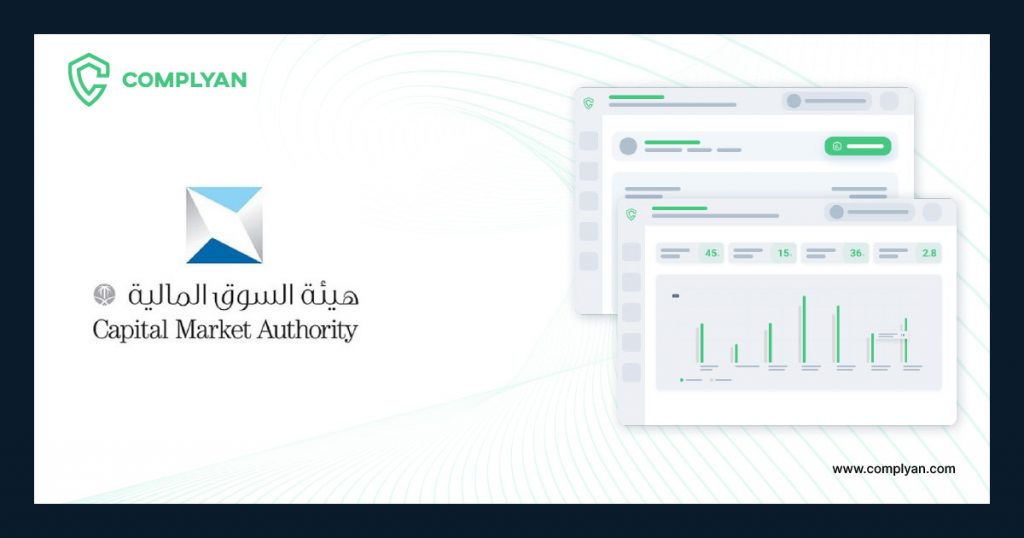Navigating the Saudi Arabia CMA Cybersecurity Guidelines with Complyan

In Saudi Arabia, the principal investment body, CMA, provides comprehensive standards and best practices to help organizations strengthen their cybersecurity posture and protect against the evolving threat landscape, especially with the way cyberattacks have grown more sophisticated and frequent, and any breach can lead to the loss of critical data, disruption of business operations, and reputational harm.
Saudi Arabia’s Capital Market Authority (CMA) Cybersecurity Guidelines were developed to help organizations protect their assets and customers against increasing cyber threats. These guidelines are essential for all financial institutions operating within Saudi Arabia, and compliance with them is critical to avoid penalties and reputational damage.
Complying with the CMA Cybersecurity Guidelines can help organizations achieve their cybersecurity objectives and establish a security culture. With the rise of regulations and the increased frequency of cyber threats, it is imperative for organizations to prioritize cybersecurity and take necessary steps to comply with industry standards such as the CMA Cybersecurity Guidelines. This blog discusses how to achieve compliance with this framework using Complyan.
Key Requirements of the Saudi Arabia CMA Cybersecurity Guidelines
The aim of Saudi Arabia’s CMA Cybersecurity Guidelines is to help financial institutions establish a reliable strategy to assess and manage their cybersecurity risks effectively. It provides cybersecurity controls across 4 domains mapped across 26 subdomains. These domains provide the basic requirements for compliance with the security guideline and include the following:
- Cybersecurity governance
- Cybersecurity risk management, review, and audit
- Operational cybersecurity controls
- Third-party cybersecurity.
Cybersecurity Governance: The domain covers 5 subdomains namely: leadership and responsibilities, data governance and security, strategy and policies, training and awareness, and human resources cybersecurity.
Security controls in this domain ensure that a financial institution’s management is committed to cybersecurity and has established effective policies and procedures. It also emphasizes the importance of training employees and fostering a cybersecurity-aware culture within the organization. This includes having a clear cybersecurity strategy, assigning responsibilities for cybersecurity, and regularly reviewing the effectiveness of the cybersecurity program.
Risk assessment, review, and audit: regular risk assessment, review, and audit is another critical requirement. The controls in this domain provide financial institutions with the template they need to establish a culture of regularly evaluating their security posture, identify gaps, make changes, review and continuously monitor to ensure that their system and process remain secure.
Operational cybersecurity controls: The operational cybersecurity controls are requirements set to ensure the protection of organizational procedures for the operation of information assets, employees, customers, and any interested parties. The domain provides guidelines across 16 subdomains, including cybersecurity structure, infrastructure security, change and project management, identity and access management, information and technology assets management, safe destruction, cybersecurity incidents management, cybersecurity event logs management, cybersecurity threat management, application protection, encryption, vulnerability management, online trading services, physical security, business continuity management, and the use of personal devices (Bring Your Own Device, or BYOD). Each subdomain is critical in establishing effective operational cybersecurity controls and periodical monitoring of the controls’ compliance helps in reducing the risk of cyber threats to financial institutions.
The fourth domain of the CMA, third-party cybersecurity, contains security controls addressing cybersecurity concerns across three subdomains: contract and supplier management, outsourcing, and cloud computing. As financial institutions increasingly depend on integrating several third-party software components to improve their service delivery, the controls in this domain provide the practices to be adopted to avoid cybersecurity compromise due to their affiliation with external services.
How Complyan Can Help Achieve Compliance

In this section, we will explore how Complyan can help financial institutions address these requirements and achieve compliance with the CMA Cybersecurity Guidelines.
Financial institutions need an all-encompassing solution that can assist them in addressing the particular needs outlined in the guidelines in order to achieve compliance with the Saudi Arabia CMA Cybersecurity Guidelines. Complyan is a SaaS platform that can provide just that.
Complyan is designed to help financial institutions manage their cybersecurity risk, and it does so by offering a range of features and tools that address the key areas of cybersecurity, including data governance, risk assessment and quantification, supply chain, and third-party security.
One of the key requirements outlined in the guidelines is the need for financial institutions to conduct regular risk assessments to identify potential cybersecurity threats and vulnerabilities. Complyan’s risk assessment feature can help institutions meet this requirement by providing a framework for conducting thorough and effective risk assessments while visualizing them to help understand their criticality.
Other requirements revolve around data security and privacy, third-party risk management, operational procedures and information security policy, all of which Complyan provides dedicated modules to comprehensively address.
Many organizations successfully use Complyan to achieve and maintain compliance with similar regulations, including the FFIEC CAT, UAE IA, and Abu Dhabi DoE CSF. Financial institutions in Saudi Arabia can be sure they have a tool that will help them comply with the CMA Cybersecurity Guidelines by adopting Complyan. With the aid of its extensive features and tools, institutions can successfully manage their cybersecurity risk while meeting the key requirements outlined in the guidelines.
Benefits of using Complyan for Compliance with the Saudi Arabia CMA Cybersecurity Guidelines
Complyan is a complete SaaS solution created to assist organizations in enhancing their cybersecurity posture and achieving compliance with various frameworks and regulations. Financial institutions can gain a lot from using Complyan in relation to the Saudi Arabia CMA Cybersecurity Guidelines. Some of these benefits include:
- Stay up-to-date with evolving cybersecurity threats: Complyan can help financial institutions stay ahead of the constantly evolving cybersecurity landscape. Its comprehensive tools and features can help organizations identify and assess cybersecurity risks, monitor their networks for vulnerabilities, and establish protocols for responding to cyber threats.
- Achieve compliance with ease: Complyan’s tools are specifically designed to address the key requirements of the Saudi Arabia CMA Cybersecurity Guidelines. By leveraging these tools, financial institutions can easily identify gaps in their cybersecurity posture, establish policies and procedures to address them, and ensure ongoing compliance with the guidelines.
- Improve overall cybersecurity posture: By using Complyan, financial institutions can improve their overall cybersecurity posture in relation to the Saudi Arabia CMA Cybersecurity Guidelines and across their entire organization. This can help protect against a wide range of cyber threats, from phishing attacks and malware to more sophisticated threats like ransomware.
- Gain a competitive edge: In today’s business landscape, cybersecurity is an increasingly important factor in maintaining a competitive edge. By demonstrating compliance with the Saudi Arabia CMA Cybersecurity Guidelines and implementing best practices for cybersecurity, financial institutions can improve customer trust and differentiate themselves from competitors.





 Governance and Policy Management
Governance and Policy Management